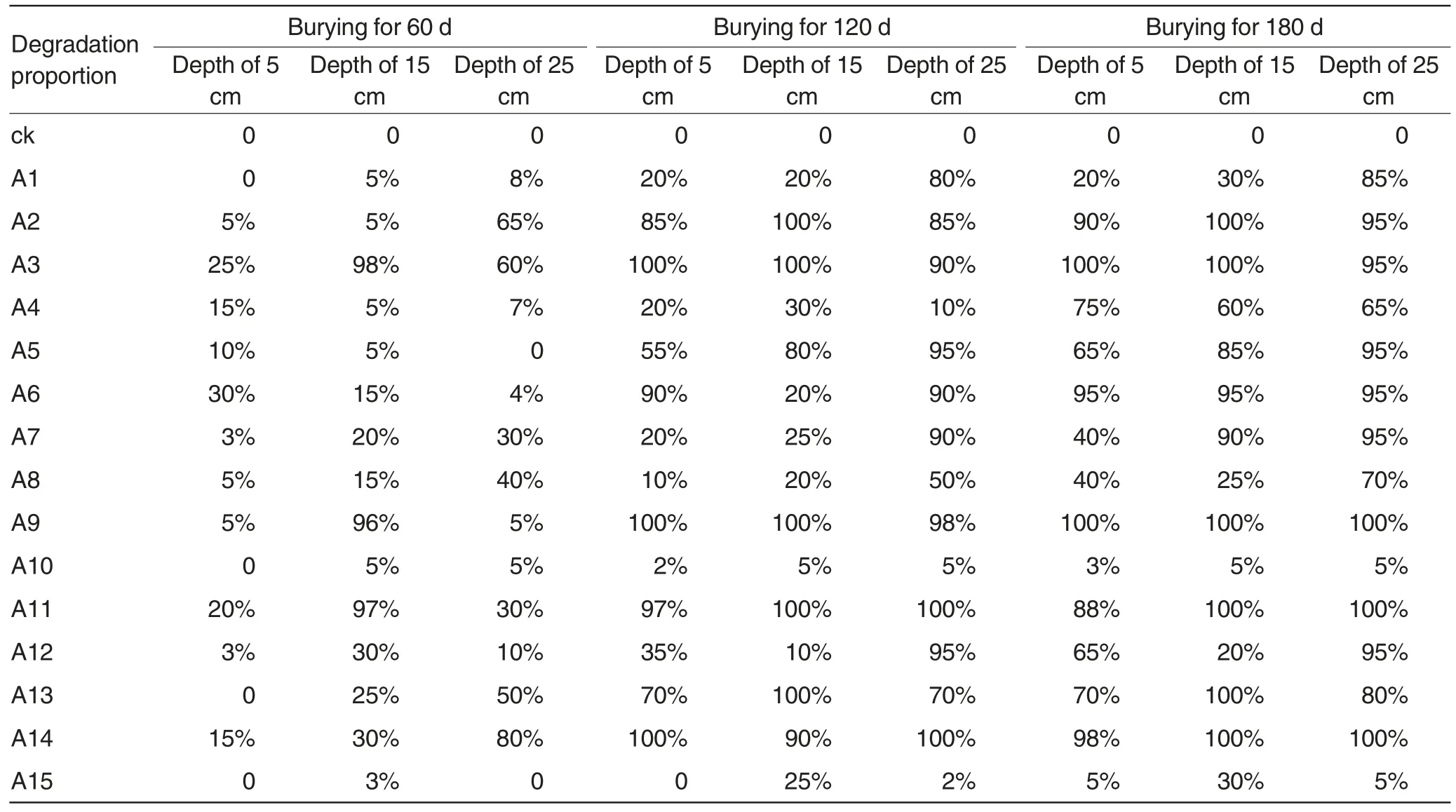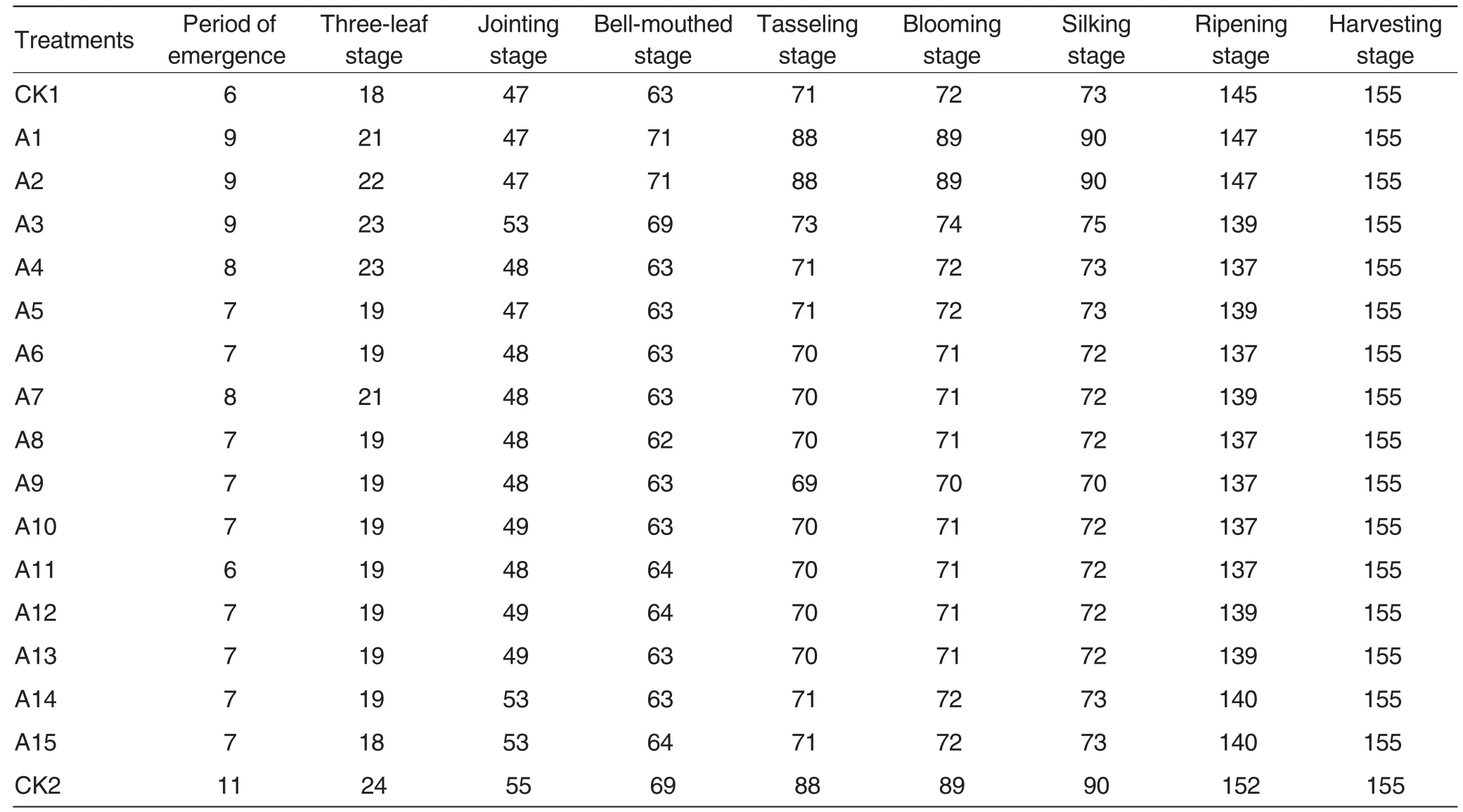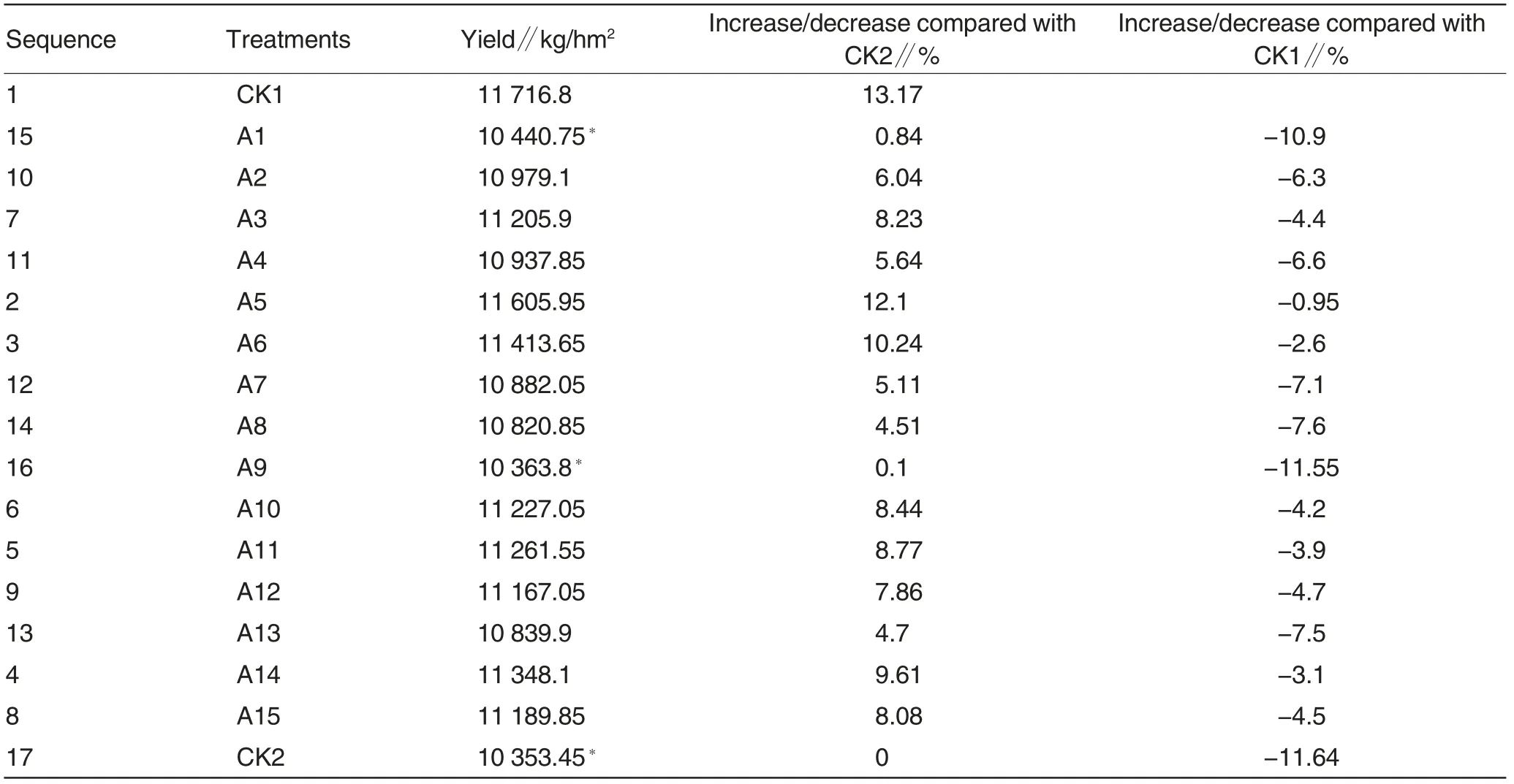Applicability of Biodegradable Mulch in Maize Production in Northeastern Yunnan
2015-12-14YunshuangDINGJimeiHUANGChengminQIANBinzhaoLIUJinZHOULiushuangNI
Yunshuang DING, Jimei HUANG, Chengmin QIAN, Binzhao LIU, Jin’e ZHOU, Liushuang NI
China Agricultural Research System Qujing Corn Experiment Station/Qujing City Academy of Agricultural Sciences, Qujing 655000, China
Northeastern Yunnan is situated in Wumeng Mountains of the Yunnan-Guizhou Plateau and lies within the humid subtropical zone.There is less rain in winter and spring,and rainy season is in hot summer and autumn. In general, rainy season starts from the end of May. In early maize growth stage,northeastern Yunnan is with less rain and insufficient accumulated temperature, and it becomes indispensible to make use of mulches for maize cultivation.However,common mulch is difficult to be degraded or recycled,and consequently,soil contamination by mulches would go worse, deteriorating eco-environment simultaneously. Therefore, the research collected 15 controllable biodegradable mulches nationwide and conducted an experiment concerning drying in the sun, soil burying,and maize cultivation with mulches in order to select controllable biodegradable mulches to replace common mulches.
Methods and Materials
Test design
Drying in the sun The test was designed as per randomized block design, including 17 treatments, and two replications, covering the treatments with 15 biodegradable mulch, the treatment with common mulch (CK1)and the treatment without mulch(CK2).Specifically,the length of every test plot is 10 m,and ridging was conducted as per 90 cm of wide row and 40 cm of narrow row. Besides, thermometers were arranged in replication 1 in the middle of the test plot, covering ground thermometer, maximum and minimum thermometers. Specifically, maximum and minimum thermometers were set on mulches in the plot with mulches and on ground in the treatment without mulches.
Test design with burying The test with burying used split plot design.Specifically,ground sample was factorA, and A1-A15 were biodegradable mulches and A16 was common mulch(CK1); ground depth was factor B,concerning three treatments of 5 cm(B1),15 cm(B2)and 25 cm(B3),with 4 replications. Furthermore, for every replication, a rectangle-shaped flat bottom pit (50×600 cm) was dug and 16 biodegradable mulches and common mulches (CK1) were cut into mulch pieces (45×20 cm), followed by tabbing. Subsequently, the samples were placed in the pits in order randomly, and then recorded to formulate a plane graph. Finally, all dug soils were refilled.
Test design of maize cultivation with mulches The test was conducted as per randomized block design, including the treatments with mulches of A1-A15,the treatment with common mulch of A16 (CK1), and the treatment without mulches of A17(CK2), with three replications and 51 test plots. The cultivation crop was maize Yunduan No.999.The length of every test plot was 20 m, and ridges were constructed with a height of 1.3 m. Besides, the maize was cultivated in wide and narrow rows with line spacing of 90 and 40 cm, respectively. Additionally, plant distance was kept 40 cm, and the test left seedling doubly.
Test materials
The degradable mulches included Huali 1# (A1), Huali 2#(A2), Huali No.3#(A3),HY—1(A4),HY—2(A5),HY—3(A6), Jinfa 1#(A7), Jinfa 2#(A8), 1#(A9), 2# (A10), 3# (A11), BASF—1(A12), BASF—2 (A13), BASF—3(A14),Yide(A15),and common mulch Qingtian(A16).
Test condition and management
The preceding crop was vegetable in the test fields,and soil plough layer reached 30 cm. The soils are sandy red soils. Maize seeds were sown on April 23, 2014 as per direct seeding with wide and narrow rows.Furthermore, decomposed dung was applied at 15 000 kg/hm2and slow-release fertilizer at 600 kg/hm2as base fertilizers. On May 23, maize was irrigated, and seedlings were thinned out and fixed. It is notable that 176 plants were maintained in every test plot. A heavy rain occurred on July 3 and precipitation was abundant in later period. Besides, additional fertilizer, disease and pest control were conducted as per local methods. Maize was harvested on September 25,2014.
Results and Analysis
Analysis on degradation of mulches in test fields
Analysis on degradation of mulches As shown in Fig.1,induction periods of the 15 degradable mulches were all fewer than the target of 70 d.Specifically, the induction period of treatment A12 reached the longest of 56 d; the periods of rest most treatments were in the range of 35-45 d;the periods of few treatments were below 20 d. As for rifting stage,degradable mulches all performedpoorly, which were far from meeting target of 85 d. For example, rifting stages of treatments A5, A6, A12 and A13 reached over 50 d, but the stage of treatment A15 just last for 20 d.Furthermore, the heavier-rifting stages of all the treatments were fewer than the target days. For example, the stages of treatments A5, A6 and A12 last longer for about 70 d. The broken periods of treatment A12 last the longest(after 175 d) and of treatment A10 reached the shortest (after 45 d). Finally, non-mulch periods just occurred in the treatments of A3, A10, A14 and A15 on the 160th or 170thd.
Effects of mulches on soil temperatures
Mulching for 4-12 d The test showed that all test mulches did not reach induction period on the 12thd of mulching, showing little differences with CK1. Compared with CK2, temperatures of soils kept increasing in the depths of 5 and 10 cm(Fig.2).
Mulching for 16-44 d Since the 16thd of mulching,degradable mulches entered induction periods in succession.It observed that soil temperature differed insignificantly among treatments at 8:00, but significantly at 17:00,which incorporated that temperature growth caused by accumulated tem-perature is considerable by mulching(Fig.3).
Mulching for 48-60 d After 48 d mulching, all degradable mulches entered induction periods and most treatments entered heavier-rifting stage except of treatments A5,A6 and A12(Fig.4).

Table 1 Degradation rates of different treatments %

Table 2 Growth stages of maize in different treatments d
Analysis on test results
As shown in Table 1, degradation rates of degradable mulches tended to be volatile upon mulch species and the effects of burying depth on degradable rates were also under the influence.
Analysis on mulching tests of maize
Analysis on degradation of mulches The induction periods of the 15 degradable mulches were all fewer than the target of 70 d. Specifically, the induction period of treatment A12 reached the longest of 56 d and of treatments A2, A10, A14 anmd A15 maintained the shortest of 16 d, suggesting that degradation process can not be effectively controlled.As for rifting stage,degradable mulches all performed poorly, which were far from meeting target of 85 d. For example,rifting stages of treatments A12 lastthe longest of 59 d and of treatment A10 the shortest of 20 d.Furthermore,the heavier-rifting stages of all the treatments were fewer than the target days of 105 d.For example,the stages of treatment A12 last the longest for about 90 d and of treatments A10 and A11 the shortest of 35 d. The broken periods of treatment A12 last the longest (175 d) and of treatment A10 reached the shortest (45 d). Finally,non-mulch periods just occurred in the treatments of A3, A10, A14 and A15 on the 160th or 170thd.
Effects of mulches on soil temperatures
Analysis on soils with the depth of 5 cm It was observed at 8:00 and 17:00 that soil temperature increased in all treatments compared with CK2.On the 4thd of mulching,soil temperature grew higher in treatments A13 and A14 than that of CK1, and soil temperatures in treatments A5, A6,A9, A10, A13 and A14 kept higher than that of CK1 on the 8thd of mulching. On the 12thd, however, soil temperatures of treatments A2, A3,A4,A6,A9 and A13 maintained higher than that of CK1.
Analysis on soils with the depth of 10 cm It was observed at 8:00 and 17:00 that soil temperatures in all treatments kept lower than that of CK1, indicating that temperature growth effects are poorer, but kept higher than that of CK2. After 4 d mulching, however, soil temperatures in treatments A13, A14 and A15 were lower than that of CK1. After 8 d mulching, in contrast, temperature growth in treatment A6 performed stronger and soil temperatures of the treatments were close to that of CK1 12 d after mulching.
Effects of degradable mulches on maize growth stage The growth stage of mulched maize last for 137-148 d, which was 7-15 d shorter than that of CK2. Besides, some of the mulched maize kept longer than CK1 in terms of growth stage, but some shorter.
Effects of mulching on disease and pest damages Generally speaking,dominated by Puccinia sorghi Schw,disease damages proved lighter and the treatments had insignificant effects on the diseases.
Effects of mulching on maize yield It can be concluded from analysis of variance that insignificant differences were shown of maize yield of 13 treatments with CK1,and significant differences were shown of the other two treatments with CK1. In contrast, 14 treatments showed little differences with CK2 in terms of maize yield, and the other treatment showed significant differences with CK2. Besides, significant differences were shown between CK1 and CK2.
Discussions
The controllability analysis on induction period
From mulch degradation in the test, it can be concluded that the in-duction period last the longest of 56 d which was still below than the target of 70 d.Therefore, it is hard for induction period to meet maize demands in terms of humidity and temperature,and the test showed that only treatments A12,A13,A6 and A7 performed better in controllability of induction periods.
The controllability analysis on rifting period In different test plots, induction periods of all degradable mulches all kept below 60 d, directly affecting the target of 85 d rifting period.Besides, only treatment A12 performed well, entering rifting period after 59 d.
The controllability analysis on heavier-rifting stage Under influence of poor controllability of induction period and rifting period,heavier-rifting stages of the degradable mulches among the treatments all maintained lower than expected 105 d.besides,of the test treatments, treatment A12 performed better,which achieved 90 d in terms of the heavier-rifting stage after 15 d in the mulching treatment and after 70 d in the treatment dried under the sun.

Table 3 Comparisons of maize yields by mulching
The exposed parts in ridges and degradation effects of mulches buried under soils
The degradation effects of exposed mulches in ridges In terms of the treatment dried under the sun, treatments A3, A10 and A14 performed better in exposed parts, so that mulches were totally degraded on the 160th, 170thand 170thd, respectively.After 190 d mulching, mulches in rest treatments all broke and the degradation effect reached over 95%. In the mulching treatment, however, treatments A2, A3, A7, A8, A11 and A10 performed better in degradation effects for the exposed parts, and the mulches were totally decomposed on the 130th, 170th, 170th, 170th, 170thand 190thd,respectively.
Degradation effects in the burying treatment In the treatment, the degradation effects of A2, A3, A6, A9,A11 and A14 were better and of the rest treatments poorer.
Mulching effect of degradable mulches
Temperature-increasing effect In early mulching stage, temperatures of soils in different treatments all kept increasing, and the effect on soils with depth of 5 cm were better than that of soils with depth of 10 cm.
Advancing maize growth For the mulched maize, key growth stage was 6-15 d earlier than that of exposed maize. Compared with CK1, key growth stages of treatments A1 and A2 were 2-17 d later,but maize in rest treatments showed similar or 1-8 d later before tasseling stage,and 1-8 d earlier after tasseling stage.
Yield increasing effect Yields of mulched maize proved all higher than yield of exposed maize, which demonstrated that degradable mulch plays the role of improve maize yield.Meanwhile, maize yields in the treatments with degradable mulches or common mulches were similar.
Results and Analysis
Poor controllability of induction period of degradable mulches
The induction periods of the 15 degradable mulches were all fewer than the target of 70 d.Specifically,the induction period of treatment A12 reached the longest of 56 d; the periods of rest most treatments were in the range of 35-45 d; the periods of few treatments were below 20 d. These demonstrated that the degradation process can not be well controlled and controllability of induction period is poor.
Similar mulching effect with that of common mulch
In the mulching treatment, most degradable mulches could meet demands of agricultural operation.In accordance with the test results, totally degradable mulches prove similar with common mulches in terms of heat preservation and yield increasing for crops, and perform excellently in covering strength, extension degree and toughness.
The role of degradable mulches in removing mulch residues
It can be concluded from drying and mulching tests that the fewer mulch residues were left or totally degraded after maize harvesting. From burying test, however, most mulches can be degraded, except of the treatment A10 where mulches in the depths of 5, 15 and 25 cm were less degraded. In general, degradable mulches would remove mulch residues in a certain period.
Expectation
The test proved that similar to common mulch, biodegradable mulch functions well in heat preservation and yield increasing, as well as resolving the issue of plastic pollution, which is of great significance in environment protection,agricultural sustainable development, and eco-agriculture, green agriculture and modernized agriculture.
Suggestion
It is necessary to further regulate controllability, anti-tensile strength and heat preservation of degradable mulches and adjust recipe proportions of raw materials to improve property and quality of degradable mulches according to growth term of crops and induction periods.
[1]MA WL (马文莲),MA QY (马全义),MA XM (马学铭), et al. Comparison research on biodegradable mulch and common mulch(生物降解膜与普通地膜的比较示范研究)[J].Inner Mongolia Agricultural Science and Technology (内蒙古农业科技),2012,(4):42-43.
[2]CHU WH(褚卫红),SHI YH(石亚辉).The function and effect of agricultural mulches and countermeasures (农用地膜在农业生产中的作用、影响及对策)[J].Inner Mongolia Agricultural Science and Technology(内蒙古农业科技),2007,(7):142-143.
猜你喜欢
杂志排行
Agricultural Science & Technology的其它文章
- Effects of Specific Gravity-based Seed Grading on Seed Germination,Seedling Emergence and Grain Yield of Hybrid Rice
- Effects of NaCl Stress on Seed Germination of Four Canavium album Raeuseh Cultivars
- Application Effects of Ultra-fine Powder Shaped Maize Seed Coating Agent in Spring Sowing areas in northeast China
- Breeding and Application of a Japonic Rice Cytoplasmic Male Sterility Line,E-Jing A
- Effect of Low Temperature and Sparse Light Conditions on Cold Tolerance of Different Rice Lines at Seedling Stage
- Molecular Marker Assisted Selection for Fusarium Wilt Resistance Breeding in Watermelon(Citrullus lanatus)
